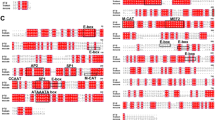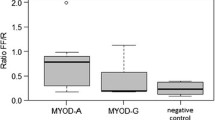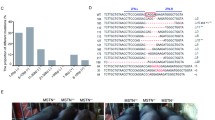Abstract
Muscle specific RING finger protein2 (MuRF2) and Muscle specific RING finger protein3(MuRF3) are two important members of the muscle specific RING finger protein family, which are especially expressed in cardiac and skeletal muscle tissues and play critical roles during the myocyte differentiation, development and morphogenesis. In this study, the molecular characteristics of porcine MuRF2 and MuRF3 gene were reported, and furthermore two variants of MuRF2 were identified. The tissue distribution pattern analyses revealed that MuRF2-b and MuRF3 mRNA was exclusively expressed in striated muscle tissues while MuRF2-a had a low-level expression in liver tissue. Real-time quantitative reverse transcriptase-polymerase chain reaction (RT-qPCR) results displayed MuRF2 mRNA expression levels were significantly varied at three stages of fetal skeletal muscle in Landrace pigs, and the expression of MuRF2-a was lower than that of MuRF2-b in all stages. An essencial region of −396 to −22 for transcription was identified at the 5’UTR of porcine MuRF2 gene, while no active regulatory fragment found in the 5’UTR of mouse MuRF2. A single nucleotide polymorphism (SNP), c.915G > A was identified in MuRF2 exon 5. A HinfI PCR-RFLP was developed for SNP genotyping in two different pig populations. Association of the genotypes with growth and carcass traits showed that different genotypes of MuRF2 were significantly (P < 0.05) associated with average daily gain on test, carcass weight and carcass length. The study suggested that the porcine MuRF2 and MuRF3 genes are involved in the muscle growth and development, and can be considered as potential candidate genes affecting muscle production traits in the pig.



Similar content being viewed by others
Abbreviations
- CDS:
-
Coding sequence
- ESTs:
-
Expressed sequence tags
- MuRF1:
-
Muscle specific RING finger protein-1
- MuRF2:
-
Muscle specific RING finger protein-2
- MuRF3:
-
Muscle specific RING finger protein-3
- ORF:
-
Open reading frame
- RFLP:
-
Restriction fragment length polymorphism
- SNP:
-
Single nucleotide polymorphism
- UTR:
-
Un-translated region
References
Centner T, Yano J, Kimura E et al (2001) Identification of muscle specific ring finger proteins as potential regulators of the titin kinase domain. J Mol Biol 306(4):717–726
Spencer JA, Eliazer S, Ilaria RL Jr et al (2000) Regulation of microtubule dynamics and myogenic differentiation by MuRF, a striated muscle RING-finger protein. J Cell Biol 150(4):771–784
Borden KL (1998) RING fingers and B-boxes: zinc-binding protein-protein interaction domains. Biochem Cell Biol 76(2–3):351–358
Freemont PS (2000) RING for destruction? Curr Biol 10(2):R84–R87
Pizon V, Iakovenko A, Van Der Ven PF et al (2002) Transient association of titin and myosin with microtubules in nascent myofibrils directed by the MURF2 RING-finger protein. J Cell Sci 115(Pt 23):4469–4482
McElhinny AS, Perry CN, Witt C et al (2004) Muscle specific RING finger-2 (MURF-2) has multiple subcellular localizations and is required for microtubule, intermediate filament, and sarcomeric M-line maintenance in striated muscle. J Cell Sci 117:3175–3188
Gregorio CC, Perry CN, McElhinny AS (2005) Functional properties of the titin/connecting-associated proteins, the muscle-specific RING finger proteins(MURFs), in striated muscle. J Muscle Res Cell Motil 26(6–8):389–400
Verner J, Humpolicek P, Knoll A (2007) Impact of MYOD family genes on pork traits in large white and landrace pigs. J Anim Breed Genet 124:81–85
Cheng H, Xu X, Zhao S et al (2010) Molecular cloning and expression profile analysis of porcine TCAP gene. Mol Biol Rep 37:1641–1647
Liu C, Gao H, Zhai S et al (2010) Molecular characterization, chromosomal localization, expression profile and association analysis with carcass traits of the porcine dickkopf homolog1 gene. Mol Biol Rep. doi:10.1007/s11033-010-0313-x
Fontanesi L, Colombo M, Tognazzi L et al (2010) The porcine TBC1D1 gene: mapping, SNP identification, and association study with meat, carcass and production traits in Italian heavy pigs. Mol Biol Rep. doi:10.1007/s11033-010-0247-3
Qiu H, Xu X, Fan B et al (2010) Investigation of LDHA and COPB1 as candidate genes for muscle development in the MYOD1 region of pig chromosome 2. Mol Biol Rep 37(1):629–636
Lunney JK (2007) Advances in swine biomedical model genomics. Int J Biol Sci 3(3):179–184
Livak KJ, Schmittgen TD (2001) Analysis of relative gene expression data using real-time quantitative PCR and the 2(-Delta Delta C(T)) Method. Methods 25:402–408
Chen H, Cheng L, Yang S et al (2010) Molecular characterization, induced expression, and transcriptional regulation of porcine S100A12 gene. Mol Immunol 47(7–8):1601–1607
Ling F, Wang T, Wei L et al (2010) Cloning and characterization of the 5′-flanking region of the pig AgRP gene. Mol Biol Rep. doi:10.1007/s11033-010-0353-2
Malek M, Dekkers JC, Lee HK et al (2001) A molecular genome scan analysis to identify chromosomal regions influencing economic traits in the pig I. Growth and body composition. Mamm genome 12(8):630–636
Tang ZL, Peng ZZ, Liu B et al (2008) Effect of breed, sex and birth parity on growth, carcass and meat quality in pigs. Front Agric China 2:331–337
Haliassos A, Chomel JC, Tesson L et al (1989) Modification of enzymatically amplified DNA for the detection of point mutation. Nucleic Acids Res 17(9):3606
Moriscot AS, Baptista IL, Bogomolovas J et al (2010) MuRF1 is a muscle fiber-type II associated factor and together with MuRF2 regulates type-II fiber trophicity and maintenance. J Struct Biol 170(2):344–353
Fielitz J, van Rooij E, Spencer JA et al (2007) Loss of muscle-specific RING-finger 3 predisposes the heart to cardiac rupture after myocardial infarction. Proc Natl Acad Sci USA 104(11):4377–4382
Antin PB, Forry-Schaudies S, Friedman TM et al (1981) Taxol induces postmitotic myoblasts to assemble interdigitating microtubule-myosin arrays that exclude actin filaments. J Cell Biol 90(2):300–308
Toyama Y, Forry-Schaudies S, Hoffman B et al (1982) Effects of taxol and Colcemid on myofibrillogenesis. Proc Natl Acad Sci USA 79:6556–6560
Lefaucheur L, Edom F, Ecolan P et al (1995) Pattern of muscle fiber type formation in the pig. Dev Dyn 203:27–41
Picard B, Lefaucheur L, Berri C et al (2002) Muscle fibre ontogenesis in farm animal species. Reprod Nutr Dev 42:415–431
Wigmore PM, Stickland NC (1983) Muscle development in large and small pig fetuses. J Anat 137(Pt 2):235–245
Zhang DX, Li K, Liu B et al (2006) Chromosomallocalization, spatio-temporal distribution and polymorphism of the porcine tripartite motif-containing 55 (TRIM55) gene. Cytogenet Genome Res 114(1):93B
Sanchez MP, Riquet J, Iannuccelli N et al (2006) Effects of quantitative trait loci on chromosomes 1, 2, 4, and 7 on growth, carcass, and meat quality traits in backcross Meishan × Large White pigs. J Anim Sci 84(3):526–537
Evans GJ, Giuffra E, Sanchez A et al (2003) Identification of quantitative trait loci for production traits in commercial pig populations. Genetics 164(2):621–627
de Koning DJ, Pong-Wong R, Varona L et al (2003) Full pedigree quantitative trait locus analysis in commercial pigs using variance components. J Anim Sci 81(9):2155–2163
Mercadé A, Pérez-Enciso M, Varona L et al (2006) Adipocyte fatty-acid binding protein is closely associated to the porcine FAT1 locus on chromosome 4. J Anim Sci 84(11):2907–2913
Weiler U, Appell HJ, Kremser M et al (1995) Consequences of selection on muscle composition. A comparative study on gracilis muscle in wild and domestic pigs. Anat Histol Embryol 24(2):77–80
Lin RS, Chen LR, Huang SC et al (2002) Electromagnetic scanning to estimate carcass lean content of Taiwan native broilers. Meat Sci 61(3):295–300
Acknowledgments
This study was financially supported by the National Natural Science Foundation of China (30771169), Wuhan Youth Chenguang Project (200750731282), the National High Science and Technology Foundation of China “863”, and the creative team project of Education Ministry of China (IRT0831). The authors thank Dr. Max Rothschild for kindly providing DNA samples of Berkshire × Yorkshire pig family.
Author information
Authors and Affiliations
Corresponding author
Rights and permissions
About this article
Cite this article
Shen, H., Zhao, S.H., Cao, J.H. et al. Porcine MuRF2 and MuRF3: molecular cloning, expression and association analysis with muscle production traits. Mol Biol Rep 38, 5115–5123 (2011). https://doi.org/10.1007/s11033-010-0659-0
Received:
Accepted:
Published:
Issue Date:
DOI: https://doi.org/10.1007/s11033-010-0659-0




